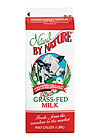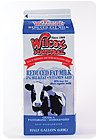
For dairy processors focused on organic and natural milk, 2006 might have been even more tumultuous than it was for the rest of the milk business. A simmering dispute over pasture access boiled over, Wal-Mart phoned in a big order, and conventional dairy processors began to introduce “naturally produced” milk, setting up a middle category of milk made without the use of rBST, but also without adherence to the USDA organic standards.
And, if you think 2006 was something, 2007 has a couple more curve balls in store. Yet those in the business report continued growth and continued confidence in the segment.
“We had another tremendous growth year,” says Chad Pawlak, pres. of Organic Farm Marketing, Thorp, Wis. “We grew by 300%, which for a company our size, it is what it is, and we’ve expanded into another 1,000 retail stores.”
Pawlak has been involved in running the company since 2004, and annual sales have grown from about $500,000 to $10 million, which puts the company in a sparsely- populated middle tier in the organic milk business, he says.
Speaking of middle tiers, some of OFM’s growth this year has come from the addition of a milk line (cheese and butter were already in place) to its Grass Point Farms division, which produces a non-organic brand. OFM’s original brand line is Wisconsin Organics. Grass Point Farms milk comes from cows that spend most of their time on managed pasture land. They are not treated with rBST but they can be treated with antibiotics when needed.
As non-rBST milk enters dairy cases already shared by conventional and organic (not to mention other specialty products) one would think that grass-fed milk might get elbowed out of the growing middle-priced tier. Pawlak does not.
“My opinion is that without third-party certification and standards, (non-rBST milk) is a real limited value added proposition,” he says. “Just to lay the needle down…I don’t think is enough for what the health and wellness consumer is asking for.”
George Siemon, CEO of Organic Valley Family of Farms says the new product line that’s emerging could be a threat to the growth of organic, but if so it will be a short-term problem.
“I think in the long run, anything that encourages consumers to care more about their food and how it is produced will ultimately lead those consumers to organic,” Siemon says, echoing similar sentiments expressed by Pawlak.
If the no-rBST milk and grass-fed milk offer only partial value additions, the milk from Natural Dairy Products, West Grove, Pa., offers a multitude of enticing features for consumers interested in organic and natural products. Its Natural by Nature brand includes milk, (and cheese, and even aerosol whipped cream) from cows that are organically certified, and pasture fed. Natural Dairy Products is not a cooperative, but its milk supply comes largely from a cooperative of traditional family-owned farms in Pennsylvania. And the milk is HTST pasteurized.

“We started out as being not much of anything and now are doing several millions of dollars a year, but we are still not much of anything compared to the bigger players,” says Ned MacArthur, the company’s president.
“There have been quite a few changes in the organic milk business in the last year or two. But that hasn’t had a big effect on us,” MacArthur says. “We cater to a more educated consumer than just someone who wants organic milk.”
Siemon’s organization, the oldest and largest organic farm cooperative in the United States, continues growing too. Its milk sales have nearly doubled in the last two years, and from 2005 to 2006 total dairy sales have gone from $242 million to $334 million. That figure is expected to climb above $450 million in 2007, he said.
In addition to packaging and marketing its own milk, Organic Valley works with conventional dairy processors to produce regional lines of fresh organic milk. Most recently it partnered with Bravo! Brands to put Organic Valley milk in vending machines.
The entire segment has been forced to deal with serious raw milk shortages in the past year, but a wave of new farmers who entered the certification around the same time to avoid a deadline for new restrictions will replenish the market this spring.
“We expect a 45% to 50% increase in April, May and June,” Siemon says.
There are concerns that the wave could destabilize prices, as the shortage already has. A stable sustainable, valuable price for farmers is one of the goals of those like Siemon who have pioneered the organic milk segment for the last 30 years.
Last spring a big shock came when Wal-Mart told its top food suppliers that they would each need to begin supplying some organic products for the world’s largest retailer. Siemon and Pawlak both said that has led to somewhat of a rush into organics from conventional food manufacturers-a rush that has brought a mixed bag of ramifications.
A new ruling on pasture access was expected within weeks of this writing, and FDA is considering a measure that would allow milk and meat from cloned animals into the food supply.

Sidebar: No Significant Difference
When USDA approved the use of rBST in 1993, it stated that there was “no significant difference” in the milk from cows treated with rBST. Some in the industry believe that statement left room for doubt among consumers, who reasoned that if there was some difference its significance might be open to debate.In 2007 it’s clear that many people prefer milk from cows that are not treated.
In September of last year, Dean Foods and HP Hood disclosed that they would no longer accept milk from treated cows at some of their plants in New England. Their disclosure came after reports appeared in a newsletter from a Vermont agriculture service.
The story drew attention to other processors like Darigold in Seattle, Dean-owned Shepp’s of Dallas, and Utah-based Gossner Foods who were implementing new restrictions for producers. A handful of conventional dairies have historically asked their raw milk suppliers not to use the synthetic hormone (including specific plants with specific labels owned by companies like Hood and Gossner), but for the first time in 13 years, companies that had stuck with “no significant difference” are making concessions and offering customers at least the option of buying milk that comes without those worries.
One of the latest is Prairie Farms, Carlinville, Ill. The co-op’s CEO Ed Mullins made it sound as if his company had no choice but to switch two of its 24 milk processing plants to rBST-free.
“We are not trying to stop the technology you are using,” he told farm members. “The problem stems from an uninformed consumer.”
Mullins says producers will sign affidavits promising not to use the synthetic hormone.
As of this writing, another well known dairy, Smith Dairy Products, Orrville Ohio, is considering the move, and whether to offer it as a line extension or to simply make the change across the board.
In late December NBC reported that FDA was just days away from allowing the milk and meat from cloned animals into the food chain. The International Dairy Foods Assn. meanwhile maintains its position that a moratorium should continue until a full dialogue on FDA’s draft Risk Assessment can take place and the Risk Assessment and Risk Management are finalized. In a position statement IDFA says “there currently is no consumer benefit in milk from cloned cows, and consumers have expressed concerns about buying food from cloned animals.”
The situation regarding cloning will continue to evolve throughout 2007. FDA’s draft Risk Assessment was published on Dec. 28, stating that “food from cloned animals is as safe as conventionally bred animals.” But the moratorium will not be lifted before the comment period ends on April 2, and it could be a year or more before it comes to market.
The draft assessment is posted atwww.fda.gov/cvm/cloning.htm, along with the Proposed Risk Management Plan, a Draft Guidance for Industry and related documents.